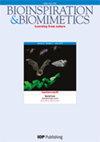Modelling human postural stability and muscle activation augmented by a supernumerary robotic tail.
IF 3.1
3区 计算机科学
Q1 ENGINEERING, MULTIDISCIPLINARY
引用次数: 0
Abstract
Wearable robots have promising characteristics for human augmentation; however, the the design and specification stage needs to consider biomechanical impact. In this work, musculoskeletal software is used to assess the biomechanical implications of having a two-degrees-of-freedom supernumerary robotic tail mounted posterior to the human trunk. Forward and backward tilting motions were assessed to determine the optimal design specification. Specifically; the key criteria utilised included the centre of pressure, the dynamic wrench exerted by the tail onto the human body and a global muscle activation index. Overall, it was found that use of a supernumerary tail reduced lower limb muscle activation in quiet stance. Furthermore, the optimal design specification required a trade-off between the geometric and inertial characteristics, and the amount of muscle assistance provided by the tail to facilitate safe physical Human-Robot interaction. .利用编外机器人尾巴模拟人体姿势稳定性和肌肉激活。
可穿戴机器人具有增强人体功能的良好特性,但在设计和规范阶段需要考虑生物力学影响。在这项工作中,使用了肌肉骨骼软件来评估安装在人体躯干后部的两自由度编外机器人尾巴对生物力学的影响。对前后倾斜运动进行了评估,以确定最佳设计规格。具体来说,采用的关键标准包括压力中心、尾部对人体施加的动态扳手以及整体肌肉激活指数。总之,研究发现,使用编外尾部可减少安静站立时下肢肌肉的激活。此外,最佳设计规格需要在几何和惯性特征以及尾部提供的肌肉辅助量之间进行权衡,以促进人与机器人的安全物理互动。
本文章由计算机程序翻译,如有差异,请以英文原文为准。
求助全文
约1分钟内获得全文
求助全文
来源期刊

Bioinspiration & Biomimetics
工程技术-材料科学:生物材料
CiteScore
5.90
自引率
14.70%
发文量
132
审稿时长
3 months
期刊介绍:
Bioinspiration & Biomimetics publishes research involving the study and distillation of principles and functions found in biological systems that have been developed through evolution, and application of this knowledge to produce novel and exciting basic technologies and new approaches to solving scientific problems. It provides a forum for interdisciplinary research which acts as a pipeline, facilitating the two-way flow of ideas and understanding between the extensive bodies of knowledge of the different disciplines. It has two principal aims: to draw on biology to enrich engineering and to draw from engineering to enrich biology.
The journal aims to include input from across all intersecting areas of both fields. In biology, this would include work in all fields from physiology to ecology, with either zoological or botanical focus. In engineering, this would include both design and practical application of biomimetic or bioinspired devices and systems. Typical areas of interest include:
Systems, designs and structure
Communication and navigation
Cooperative behaviour
Self-organizing biological systems
Self-healing and self-assembly
Aerial locomotion and aerospace applications of biomimetics
Biomorphic surface and subsurface systems
Marine dynamics: swimming and underwater dynamics
Applications of novel materials
Biomechanics; including movement, locomotion, fluidics
Cellular behaviour
Sensors and senses
Biomimetic or bioinformed approaches to geological exploration.
 求助内容:
求助内容: 应助结果提醒方式:
应助结果提醒方式:


